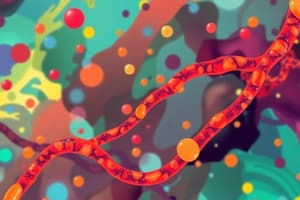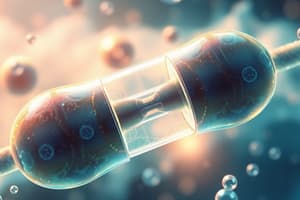Podcast
Questions and Answers
What process involves the movement of a substance from its site of administration to circulating fluids?
What process involves the movement of a substance from its site of administration to circulating fluids?
Which factor does NOT influence the absorption of a drug?
Which factor does NOT influence the absorption of a drug?
What is the main barrier that some medications must cross to affect the central nervous system?
What is the main barrier that some medications must cross to affect the central nervous system?
Which organ is primarily responsible for drug metabolism?
Which organ is primarily responsible for drug metabolism?
Signup and view all the answers
What is the effect of CYP enzyme induction on drug metabolism?
What is the effect of CYP enzyme induction on drug metabolism?
Signup and view all the answers
Which of the following drug interactions involves one drug displacing another from protein binding sites in plasma?
Which of the following drug interactions involves one drug displacing another from protein binding sites in plasma?
Signup and view all the answers
What is the hepatic portal circulation's role after oral drug administration?
What is the hepatic portal circulation's role after oral drug administration?
Signup and view all the answers
Which factor does NOT significantly affect drug distribution in the body?
Which factor does NOT significantly affect drug distribution in the body?
Signup and view all the answers
What is the term for the process in which drugs are metabolized to an inactive form by the liver before entering the systemic circulation?
What is the term for the process in which drugs are metabolized to an inactive form by the liver before entering the systemic circulation?
Signup and view all the answers
Which of the following factors does NOT influence drug excretion?
Which of the following factors does NOT influence drug excretion?
Signup and view all the answers
What best describes the minimum effective concentration of a drug?
What best describes the minimum effective concentration of a drug?
Signup and view all the answers
What occurs during the onset phase of drug action?
What occurs during the onset phase of drug action?
Signup and view all the answers
How is a loading dose defined in pharmacotherapy?
How is a loading dose defined in pharmacotherapy?
Signup and view all the answers
Which phase in a graded dose response curve indicates that increasing the dosage no longer provides additional therapeutic effects?
Which phase in a graded dose response curve indicates that increasing the dosage no longer provides additional therapeutic effects?
Signup and view all the answers
What is meant by the term 'therapeutic index'?
What is meant by the term 'therapeutic index'?
Signup and view all the answers
What does potency refer to when discussing a drug's effectiveness?
What does potency refer to when discussing a drug's effectiveness?
Signup and view all the answers
Study Notes
Pharmacokinetics Overview
- Study of drug movement and how the body processes medications.
- Involves four key processes: absorption, distribution, metabolism, and excretion.
Absorption
- Movement of a drug from administration site to circulating fluids.
- Crucial for drug efficacy; determines time to onset of action.
- Factors influencing absorption include:
- Drug formulation, dose, and route of administration.
- Size of drug molecules and surface area of absorption sites.
- Digestive motility and blood flow.
- Lipid solubility and ionization.
- Impact of certain foods.
Distribution
- Involves transport of drugs throughout the body post-absorption.
- Factors affecting distribution:
- Blood supply is the primary factor.
- Tissues can accumulate and store drugs.
- Protein binding can limit drug availability to target cells.
- Drug-drug interactions can alter distribution:
- Addition, synergism, antagonism, and displacement.
- Challenges include crossing the blood-brain barrier and fetal-placental barrier.
Metabolism
- Chemical conversion of drugs into forms easier for the body to excrete.
- Primary site: liver, with kidneys and the intestinal tract also having significant metabolic activity.
- The hepatic microsomal enzyme system (CYP enzymes) inactivates drugs and aids in excretion.
- Metabolism may produce more active metabolites.
- Some drugs can induce increased metabolic activity while others can inhibit it.
- First pass effect occurs when drugs are metabolized in the liver before systemic circulation.
Excretion
- Process of drug removal from the body; primarily via kidneys.
- Other routes include the respiratory system, gallbladder, and biliary tract.
- Drug excretion factors:
- Liver and kidney function, blood flow, ionization, lipid solubility, protein-drug complexes, metabolic activity, and pH levels.
Drug Plasma Concentration and Therapeutic Response
- Therapeutic effects of drugs relate to their plasma concentrations.
- Minimum effective concentration is needed for therapeutic effects.
- Toxic concentrations can lead to serious adverse reactions.
Pharmacokinetic Measurement Terms
- Onset: Time for the drug to exert a therapeutic effect.
- Peak plasma level: Highest concentration of medication in blood.
- Duration of action: Duration of therapeutic effect.
- Plasma half-life: Time required for the body to reduce the drug’s concentration by half.
Dosing Strategies
- Loading dose: Higher initial dose to quickly raise plasma levels.
- Maintenance dose: Sustaining plasma concentrations in a therapeutic range.
Pharmacodynamics Overview
- Examines how medications alter body functions.
- Median effective dose represents the dose at which a therapeutic effect is achieved.
Drug Safety Metrics
- Median lethal dose indicates the toxicity; therapeutic index measures drug safety.
- Median toxic dose refers to dose causing toxicity.
Dose-Response Relationship
- Graded dose-response phase 1: Minimal effect at low doses.
- Phase 2: Increased doses result in increased therapeutic response.
- Phase 3: Plateau effect where higher doses do not enhance therapeutic response.
Potency and Efficacy
- Potency reflects the drug's strength in eliciting a therapeutic response.
- Efficacy describes the drug's ability to achieve the desired therapeutic effect effectively.
Studying That Suits You
Use AI to generate personalized quizzes and flashcards to suit your learning preferences.
Related Documents
Description
This quiz covers the essential concepts of pharmacokinetics and pharmacodynamics, focusing on the movement of drugs within the body and their effects. Explore the four key processes of pharmacokinetics: absorption, distribution, metabolism, and excretion. Test your understanding of how the body processes medications and the implications for drug therapy.




